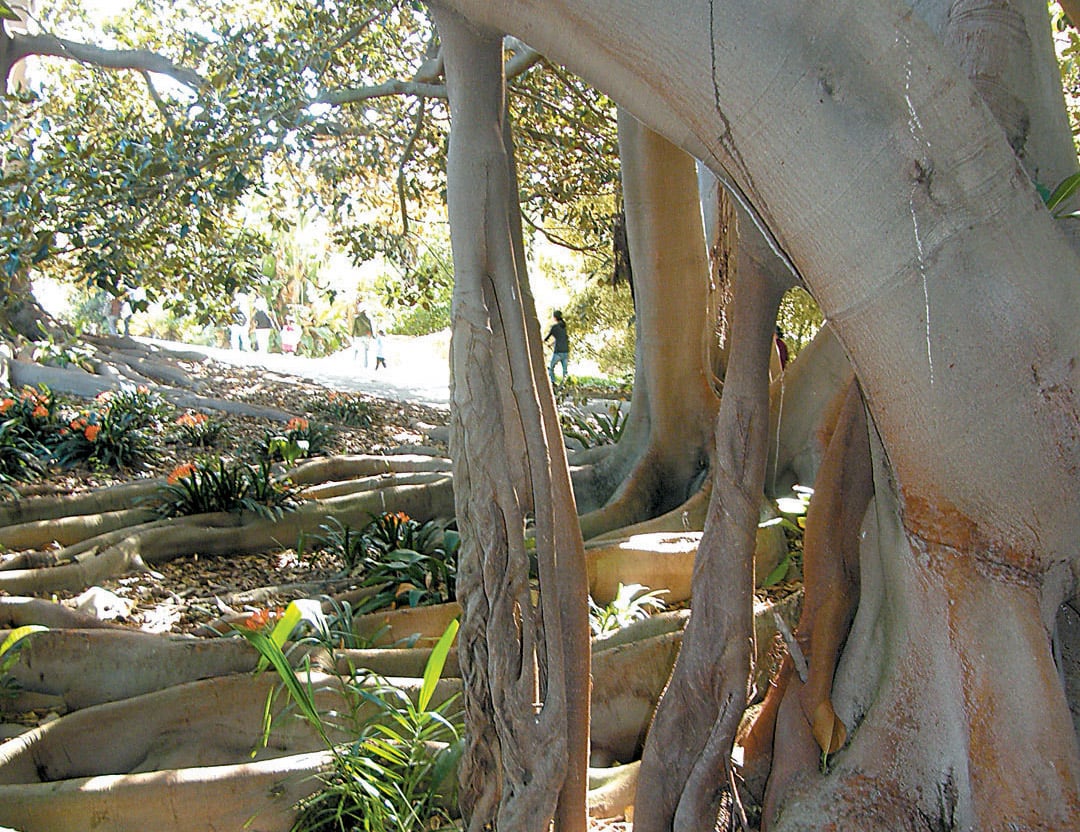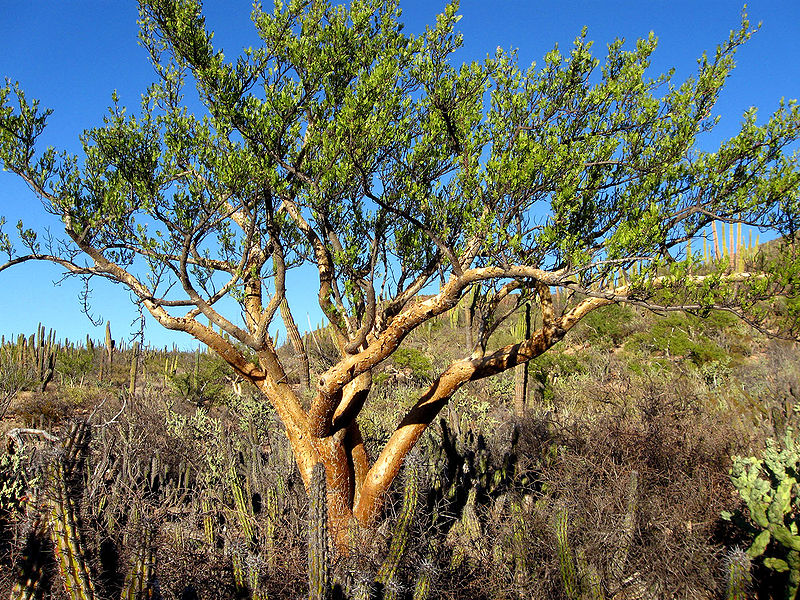

Contributor
- Topics: Archive, Inspired Gardens and Design

The author wrote of the remarkable evolution of the South Coast Botanic Garden, from landfill site to a jewel of the Palos Verdes Peninsula, in the November 2009 issue of Pacific Horticulture. She returns for the first in an occasional series on the trees to be discoverd among the garden’s treasures.
Of all the trees in the world, probably the most distinctive in shape and form is the banyan tree. Originally, the word “banyan” was used exclusively as the common name for Ficus benghalensis, a tree native to India; now, however, banyan is used just as commonly for other trees in the genus that have a similar habit and lifestyle. The word was picked up by the Portuguese and, later, the English to refer to the merchants, or banias, who took advantage of the shade and cool air under the canopy of the banyan trees to sell their products. Hence, banya actually referred to “merchant or grocer” rather than to the tree. Today, the meaning has shifted to the tree rather than the people who are gathered to do business in its shelter.
The fruits of a banyan tree are consumed by birds or bats, and the sticky seeds are commonly deposited on branches in the crown of another tree. When a seed germinates in a treetop, the seedling grows as an epiphyte upon the host tree. As an epiphyte, the seedling has access to full sunlight enabling food production through photosynthesis; the roots anchor the seedling and absorb water from the surface of the host tree. In time, the seedling produces aerial roots that grow down the side of the host tree’s trunk and enter the ground. As more of these roots descend to the forest floor, they eventually encircle the trunk of the host tree and “strangle” it, by preventing the trunk from increasing in girth. The aerial roots of this “strangler fig” merge to form a whole new trunk as the host tree rots away. As the banyan tree continues to grow, its large horizontal branches produce more aerial roots that grow toward the ground and become prop roots to support the massive weight of the branches.

Visitors to the South Coast Botanic Garden are treated to a large collection of fig trees (Ficus spp.). Belonging to the mulberry family (Moraceae), the genus Ficus is represented by approximately 800 species worldwide. The garden’s Banyan Grove, located along the tram road on the north side of the botanical garden and running parallel to Crenshaw Boulevard, occupies a strip of land approximately the size of a football field and contains, arguably, the state’s most densely planted collection of Moreton Bay fig trees (Ficus macrophylla). Here are nineteen individual trees of the subspecies macrophylla, which is native to the rainforests of eastern Australia, from central Queensland to southern New South Wales. Its large, roughly elliptical leaves are distinctive for their dark green color on top and the rusty tomentum beneath; new leaves are protected by a sheath that falls as the leaf matures. In addition, the grove includes three specimens of the subspecies columnaris from Lord Howe Island, distinguished by its smaller leaves with little or no rusty tomentum on the underside. Also planted in this section are three Indian laurel figs (F. microcarpa, syn. F. retusa) and a rubber tree (F. elastica).

Creating Its Own Microclimate
A stroll through this Banyan Grove during the hot days of summer offers a great cooling relief with lower temperatures and higher humidity. There is a continual rain-like drop of fruits onto the leaf litter and the tram road. When the wind blows, the sounds of branches rubbing together produces eerie squeaking noises—virtually the same as might be heard in any tropical forest. When the crows are congregating in the canopy, the sound of falling fruit is intensified, on top of their incessant chatter. The sinuous curves of buttressed roots extending out from the tree trunks delight the eyes. These roots add stability to the trunks to counter the weight of the huge leafy crowns. Buttressed tree trunks are common in tropical forests, where soils are thin and there is danger of toppling in severe winds. The roots are massive and capable of doing harm to hardscape elements, such as walls, foundations, walkways, and pavement, so caution is warranted when planting these large figs near such structures. Aerial roots commonly project from the trunks or hang from spreading branches.

On a walk through the Banyan Grove, Don Walker, one of the original South Coast Botanic Garden Foundation board members, shared that this area of the garden was particularly windy in the early years. The garden staff decided in the late 1960s that a mass planting of Moreton Bay figs would provide a substantial windbreak. That is, indeed, the case today; as the visitor walks into the dense shade of the grove, there is virtually no wind evident. The reduced light levels on the forest floor provide little photosynthetic energy for understory plantings. Successfully tolerating these conditions have been Kaffir lily (Clivia miniata), ivy tree (×Fatshedera), Philodendron evansii, leatherleaf fern (Rumohra adianthiformis), orange Chinese lantern (Abutilon hybridum), false aralia (Schefflera elegantissima), Boston fern (Nephrolepis exaltata), cast iron plant (Aspidistra elatior), and Mexican climbing bamboo (Chusquea coronalis).

More Ficus
Directly across from the Banyan Grove, the tram road is joined by Ficus Lane. At the southwest corner of this intersection are more species of the genus Ficus. Mysore fig (F. mysorensis) is laden with bright red fruit that, when ripe, litter the ground conspicuously. Nearby are three specimens of banyan fig (F. benghalensis), one of which prominently exhibits a well-developed prop root descending from a horizontal branch. Also in this section is higuera (F. petiolaris), a Mexican tree with a soft golden bark on trunk and branches, as well as common fig (F. carica), familiar to most as the source of edible figs.
Further down Ficus Lane, a large area to the southeast is devoted to even more examples of the genus. Of particular note are sycamore fig (Ficus sycomorus), with fruits prominently displayed all along the branches, and rusty fig (F. rubiginosa), bearing striking dark green leaves with rusty colors beneath. Also located in this section is F. insipida and bo tree, or sacred fig (F. religiosa), both of which were accessioned into the collection in 1987.
The remainder of the Ficus collection may be appreciated on the left side of Canyon Road. Zulu or Kaffir fig (Ficus lutea, syn. F. nekbudu) is native to South Africa and Madagascar; it can be seen near another banyan fig. A solitary Moreton Bay fig, accessioned into the collection in 1968, provides a huge canopy over the entire area. Broom-cluster fig (F. sur, syn. F. capensis) is usually laden with fruit along the trunk and branches. Further on, the visitor is greeted in the spring by the giant new red leaves of Roxburg fig (F. auriculata, syn. F. roxburghii), which is native to the Himalayas. As Canyon Road runs parallel to the tram road, it is possible to view more species across from the Banyan Grove. The typical green weeping fig (F. benjamina) and a striking variegated individual (‘Variegata’), generally seen as potted houseplants, thrive outdoors in this location. Surprisingly, two large specimens of fiddle-leaf fig (F. lyrata), native to tropical Africa, also are doing well in this location.
In mid-January 2007, the Los Angeles area was subjected to unusually low temperatures that even impacted the coastal zone. South Coast Botanic Garden experienced freezing temperatures for at least two days, during which time the lake formed a thin layer of ice. The fig collection was dramatically affected by this sudden cold weather, with the most severe damage occurring to Ficus auriculata, F. barteri, F. benghalensis, F. elastica, F. insipida, F. lyrata, F. petiolaris, F. religiosa, F. rubiginosa, and F. sycomorus. Moderately damaged were F. benjamina ‘Variegata’, F. lutea, F. mysorensis, and F. sur. Plants growing under or near the Moreton Bay fig canopy were protected from the frost damage that afflicted surrounding plantings. Today, almost all the figs have recovered, sprouting either from undamaged branches or trunks, or, in the most severely damaged cases, from the base of the trunks.
The Ficus collection is one of the highlights of the South Coast Botanic Garden, and plant enthusiasts planning a visit for the first time should make an effort to include this outstanding feature in their tour.

If You Should Like to Visit . . .
The South Coast Botanic Garden is operated by the Los Angeles County Department of Parks and Recreation in conjunction with the South Coast Botanic Garden Foundation. The Garden is located at 26300 Crenshaw Blvd, Palos Verdes Peninsula, CA 90274. For more information call 310/544-6815, or visit www.southcoastbotanicgarden.org for a map of the garden, a listing of current classes and special programs, what’s in flower for the month, Discovery Garden events, a membership form, and volunteer opportunities.
Share:
Social Media
Garden Futurist Podcast
Most Popular
Videos
Topics
Related Posts

Ground Up Science for Greener Cities with Garden Futurist Dr. Alessandro Ossola
Spring 2023 Listen to the Podcast here. Alessandro Ossola is a scientist who gets very excited about the challenge of climate change allowing for an

Readying Urban Forests for Climate Realities with Garden Futurist Dr. Greg McPherson
Winter 2023 Listen to the Podcast here. “Going from the mow and blow to a more horticulturally knowledgeable approach to maintaining the landscape. And that

Welcome, Greywater, to the Garden
Summer 2022 Oh, summer: delightful warm air, tomatoes swelling on the vine, fragrant blooms on an evening stroll. When it’s warm and rainless, how is

Big Tree-Data and Big-Tree Data with Garden Futurist Matt Ritter
Summer 2022 Listen to the full Garden Futurist: Episode XV podcast here. We are in an environmental crisis right now in many parts of California








Responses